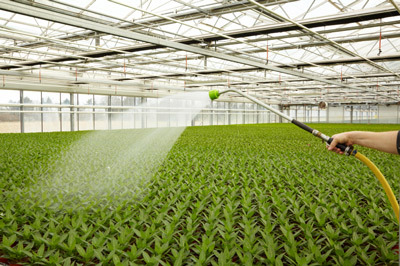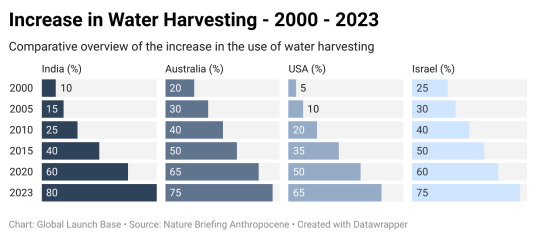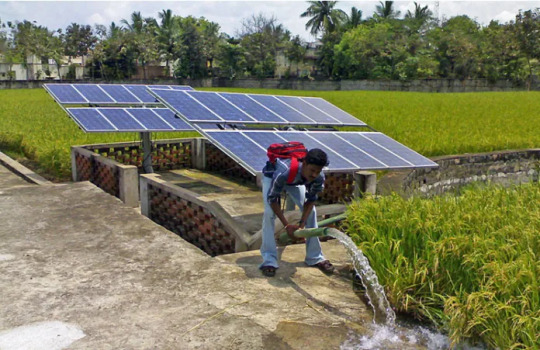#RenewableEnergyInAgriculture
Text
Water and Electricity Harvesting in Agriculture

Written By: Jagriti Shahi
Agriculture is the backbone of civilization, but it faces a growing challenge: resource scarcity. Water tables are dropping, and traditional electricity sources can be expensive and environmentally unfriendly. However, innovative solutions are emerging that combine water and electricity harvesting to create a more sustainable future for farming. In an era where sustainable practices are no longer optional but essential, the integration of water and electricity harvesting into agriculture represents a transformative approach. This innovation not only addresses the critical issues of resource scarcity and environmental degradation but also enhances the efficiency and productivity of modern farming. By combining water management and renewable energy generation, farmers can create a more resilient and self-sufficient agricultural system.
Water: The Lifeblood of Agriculture
Water is essential for plant growth, and traditional irrigation methods can be highly water-intensive. Here's where water harvesting comes in. By collecting rainwater and runoff through techniques like ponds, swales, and cisterns, farmers can create a reliable source of irrigation without relying on depleting groundwater reserves. Additionally, drip irrigation systems deliver water directly to the plant roots, minimizing evaporation and waste.
Harnessing the Power of the Sun
Electricity is crucial for powering pumps, lights for greenhouses, and other essential farm equipment. Solar panels offer a clean and sustainable solution. By installing solar photovoltaic (PV) systems, farms can generate their own electricity, reducing dependence on the grid and lowering energy costs.
Agrivoltaics in India

Figure: Certain crops can tolerate moderate shading. - Source: Image: Fraunhofer Institute for Solar Energy Systems ISE
India is also exploring the concept of agrivoltaics, where solar panels are installed above crop fields. This approach not only generates electricity but also provides partial shade for crops, reducing water evaporation and enhancing crop yields. Projects in states like Gujarat have demonstrated the viability and benefits of this dual-use land approach.
The Synergy of Water and Electricity Harvesting
The beauty lies in the synergy between these technologies. The electricity generated by solar panels can power pumps that utilize harvested rainwater for irrigation. This creates a closed-loop system, minimizing reliance on external resources and promoting environmental sustainability.
Agriculture is heavily dependent on water and energy. Traditionally, these resources have been sourced independently, often leading to inefficiencies and unsustainable practices. However, by harvesting water and electricity in tandem, farmers can optimize their resource use and reduce their environmental footprint.
Water Harvesting Techniques

Figure: Rainwater Harvesting for Agriculture - Source Rainharvesting Systems
Water harvesting involves collecting and storing rainwater or surface runoff for agricultural use. Several techniques can be employed, each suitable for different climates and terrains:
Rainwater Harvesting: Collecting and storing rainwater from rooftops or other surfaces in tanks or reservoirs.
Surface Runoff Harvesting: Capturing runoff from fields and directing it to storage ponds or recharge structures.
Subsurface Water Harvesting: Utilizing techniques like check dams and percolation pits to enhance groundwater recharge.
These methods ensure a reliable water supply, even in arid regions, reducing dependence on erratic rainfall or over-exploited groundwater resources.
Water Harvesting Comparis

The figure provided earlier shows the increase in the use of water harvesting techniques in India, Australia, the USA, and Israel over a 23-year period, from 2000 to 2023. Each percentage value represents the proportion of the population or entities adopting water harvesting techniques as part of water management practices for that respective year.
In India, the proportion of adoption increased from 10% in 2000 to 80% in 2023.
In Australia, it increased from 20% in 2000 to 75% in 2023.
In the USA, it increased from 5% in 2000 to 65% in 2023.
In Israel, it increased from 25% in 2000 to 75% in 2023
India:
Rainwater Harvesting: India has over 4.75 million traditional rainwater harvesting structures, according to the Central Ground Water Board.
Micro-Irrigation Coverage: As of 2021, India has approximately 10.65 million hectares under micro-irrigation, according to the Ministry of Jal Shakti.
Global:
United States: The US has seen a steady increase in rainwater harvesting adoption, with over 55,000 systems installed across the country.
Australia: Australia boasts over 80% adoption of micro-irrigation in its agriculture sector, significantly higher than many other countries.
Israel: Israel is a global leader in drip irrigation technology, with around 75% of its irrigated land utilizing drip systems, according to the Israeli Ministry of Agriculture.
Electricity Harvesting Methods
On the energy front, renewable technologies offer promising solutions for agriculture. Key methods include:
Solar Power: Photovoltaic panels can be installed on farm buildings, over irrigation canals, or even integrated into greenhouse structures to generate electricity.
Wind Power: Small-scale wind turbines can provide a significant portion of the energy needs for farms, especially in windy regions.
Biogas Production: Organic waste from livestock and crop residues can be converted into biogas, which can be used for heating, electricity generation, or as a fuel.

Figure: Using Solar Energy for Agriculture - Ecoideaz
Integrating Water and Electricity Harvesting
The integration of these systems can create a synergistic effect, enhancing overall farm sustainability. Here’s how:
Solar-Powered Irrigation: Combining solar panels with water pumps enables farmers to irrigate their fields using renewable energy, reducing reliance on grid power and diesel generators.
Energy-Efficient Water Storage: Using solar or wind energy to power water pumps for filling storage tanks or reservoirs can significantly cut energy costs.
Enhanced Water Management: Sensors powered by renewable energy can monitor soil moisture levels and automate irrigation systems, ensuring optimal water use and improving crop yields.
Electricity Harvesting Comparison

The figure presents the estimated increase in the use of electricity harvesting techniques in Australia, the USA, and Israel over a span of 23 years, from 2000 to 2023. Each percentage value represents the proportion of electricity generated from renewable sources (such as solar and wind power) as part of the total electricity generation for that respective year.
In Australia, the proportion of electricity generated from renewable sources increased from 5% in 2000 to 70% in 2023.
In the USA, the proportion increased from 3% in 2000 to 50% in 2023.
In Israel, it increased from 2% in 2000 to 60% in 2023.
India:
Solar Pump Installations: Under the PM-KUSUM scheme, India aims to install 1.75 million standalone solar pumps by 2022, with a cumulative capacity of 2.75 GW.
Solar Energy Generation: India's total installed solar capacity surpassed 45 GW as of 2021, with a significant portion allocated for agricultural use.
Global:
United States: The US leads in solar energy generation, with over 97 GW of installed solar capacity, contributing to both grid supply and on-farm electricity generation.
Australia: Solar-powered irrigation systems are gaining traction in Australia, with estimates suggesting over 5,000 solar pumps installed across the country.
Israel: Israel's solar energy capacity is comparatively smaller but growing rapidly, with a focus on providing clean energy solutions for agriculture.
Case Studies and Examples
Several innovative projects worldwide exemplify the benefits of integrating water and electricity harvesting in agriculture:
The Sahara Forest Project: This initiative in Jordan and Tunisia combines solar power, desalination, and sustainable agriculture. Solar energy is used to desalinate seawater, providing fresh water for crops, while excess energy supports local communities.
India’s Solar Irrigation Pumps: The Indian government has promoted the use of solar-powered irrigation pumps to help farmers access water efficiently and affordably, reducing their dependence on unreliable grid electricity.
China’s Agrivoltaics: In regions like Gansu Province, solar panels are installed above crop fields, providing shade for plants and generating electricity simultaneously. This dual-use approach maximizes land use efficiency.
The Dhundi Solar Cooperative: In Gujarat, the Dhundi Solar Cooperative has empowered farmers to generate solar power and sell surplus electricity to the grid. This initiative has provided farmers with a reliable income stream while promoting sustainable energy use.
Watershed Development in Maharashtra: The Pani Foundation’s watershed development projects have transformed arid regions into productive agricultural lands by implementing comprehensive water harvesting and management practices.
Solar Microgrids in Bihar: In Bihar, solar microgrids have been set up to provide reliable electricity to rural areas, supporting agricultural activities and improving the overall quality of life for farmers.
Companies Leading the Way
Several companies are at the forefront of integrating water and electricity harvesting in agriculture, providing innovative solutions to farmers:
Tata Power Solar: A leading solar energy company in India, Tata Power Solar provides solar irrigation solutions, including solar pumps and microgrids, enhancing energy access and sustainability for farmers.
Claro Energy: Specializing in solar-powered water pumping solutions, Claro Energy offers a range of solar pump systems designed to meet the irrigation needs of farmers across various regions in India.
DeHaat: An agritech company that supports farmers with end-to-end services including water management solutions and renewable energy products to improve agricultural productivity and sustainability.
KSB Limited: Known for its efficient water management systems, KSB provides advanced pumps and irrigation systems, integrating solar power to enhance water use efficiency in agriculture.
Amplus Solar: This company is involved in setting up solar power projects, including those tailored for agricultural applications, providing clean energy solutions to support irrigation and other farm operations.
Mahindra Susten: Part of the Mahindra Group, this company offers solar energy solutions, including solar water pumps, to promote sustainable farming practices in India.
Husk Power Systems: Specializes in decentralized renewable energy systems, including mini-grids powered by solar and biomass, which can be used to support agricultural activities in rural areas.
Government Support Programs for Water and Electricity Harvesting
The Indian government recognizes the importance of water and electricity harvesting for sustainable agriculture and has launched several programs to encourage their adoption:
Pradhan Mantri Krishi Sinchai Yojana (PMKSY): This flagship program aims to improve irrigation infrastructure and promote water conservation practices like micro-irrigation. It provides financial assistance to farmers for installing drip and sprinkler irrigation systems.
Kisan Urja Suraksha Evam Utthan Mahabhiyan (KUSUM): This scheme aims to promote solar power adoption in the agricultural sector. It provides subsidies for farmers to install grid-connected, off-grid, and solar pump irrigation systems.
National Mission on Sustainable Agriculture (NMSA): This mission focuses on promoting climate-resilient agricultural practices, including water conservation and efficient use of resources. It provides support for research and development of water-saving technologies and capacity building for farmers.
PM-KUSUM (Pradhan Mantri Kisan Urja Suraksha evam Utthaan Mahabhiyan): This flagship scheme promotes the use of solar energy in agriculture. It provides financial assistance for the installation of solar pumps, grid-connected solar power plants, and decentralized solar energy systems. The scheme aims to install over 2 million solar pumps, reducing farmers' dependence on grid electricity and diesel.
National Solar Mission: Part of the National Action Plan on Climate Change, this mission aims to establish India as a global leader in solar energy. It includes provisions for supporting solar irrigation and solar-powered cold storage facilities to reduce post-harvest losses and enhance agricultural productivity.
Atal Bhujal Yojana (ABY): This scheme aims to improve groundwater management in water-stressed areas. It promotes community participation in water management and supports the adoption of water-efficient agricultural practices.
Jal Shakti Abhiyan: A campaign aimed at water conservation and rainwater harvesting across India. It encourages the adoption of water-efficient practices in agriculture, such as micro-irrigation and watershed management, to ensure sustainable water use.
Challenges and Future Directions
Despite the clear benefits, integrating water and electricity harvesting in agriculture faces several challenges:
Initial Costs: The installation of renewable energy systems and advanced water management infrastructure requires significant upfront investment.
Technical Expertise: Farmers need training and support to manage and maintain these integrated systems effectively.
Policy Support: Government policies and incentives play a crucial role in promoting the adoption of these technologies.
Looking ahead, advances in technology and supportive policies will be critical in overcoming these challenges. Innovations such as more efficient photovoltaic cells, low-cost water storage solutions, and smart farming technologies will further enhance the viability of this integrated approach.
Conclusion
Agriculture with water and electricity harvesting represents a forward-thinking model for sustainable farming. By harnessing renewable energy and efficient water management techniques, farmers can improve their productivity, reduce their environmental impact, and build resilience against climate change. As we strive towards a more sustainable future, the integration of these practices will be essential in transforming the agricultural landscape, ensuring food security, and protecting our planet’s precious resources.
-x-
About Global Launch Base:
Global Launch Base helps international startups expand in India. Our services include market research, validation through surveys, developing a network, building partnerships, fundraising, and strategy revenue growth. Get in touch to learn more about us.
Contact Info:
Website: www.globallaunchbase.com
LinkedIn: https://www.linkedin.com/company/globallaunchbase/
Email: [email protected]
#hashtag#WaterHarvestingTechniques hashtag#ElectricityHarvestingMethods#SustainableWaterManagement hashtag#RenewableEnergyInAgriculture#RainwaterHarvestingSystems hashtag#SolarPowerForAgriculture#WindEnergyInFarming hashtag#IrrigationEfficiency hashtag#GreenFarmingPractices#HarnessingNaturalResourcesInAgriculture hashtag#EcoFriendlyFarmingSolutions#OffGridAgricultureSystems hashtag#SustainableIrrigationTechnologies#EnergyEfficientFarming hashtag#WaterConservationStrategies
0 notes